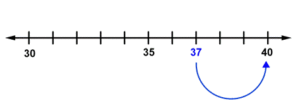Five or more raise the score, four or less give it a rest! This saying and others similar to it are often used to help students remember how to round numbers. When these students are asked why they rounded 48 to 50, they explain that the 8 in the number 48 is five or more, so they raised the score. They are not able to explain that because 48 is only 2 away from 50, but is 8 away from 40, 48 should be rounded to 50. Open number lines can help students build conceptual understanding of how to round numbers.
How to get students to use open number lines when rounding:
To build understanding of using open number lines to round, engage students with a human number line. Challenge students to round the number 76 to the nearest 10. Write the number 76 on an index card. Use a string (that 2 students hold) and have a student place the index card on the string with a clothes pin. Pose the question “What are the two closest tens to 76?” Students place the numbers 70 and 80 on either side of 76. Finding the mid-point between 70 and 80 will also help students know exactly where 76 should be on the number line. Ask students “Which ten is 76 closest to?” They will be able to see that 76 is closer to 80. They should also be able to explain that 76 is 4 away from 80.
After practice with a human number line, some students will be able to sketch an open number when rounding. Continue to expose students to this strategy when sequencing students while sharing their work.
For more information about using human number lines to round numbers, visit this website: http://peppyzestyteacherista.com/2014/10/human-number-line.html


Pingback: The Wheels on the Bus go Round and Round… Has nothing to do with Rounding but this does! | SMathSmarts